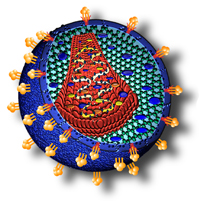Our Science – RRL Website
HIV DRP Retroviral Replication Laboratory

|
| In addition to the information presented below, the RRL has an alternative website that can provide you with more detail about their work. |
Research
The Retroviral Replication Laboratory (RRL) focuses on obtaining a detailed understanding of important events in the life cycle of the human retroviruses HIV-1 and HTLV-1, from the initial interactions between the viruses and host cell through reverse transcription to mechanisms of virus assembly and release. There is extensive work on the biochemistry and biology of reverse transcriptase (RT), its interaction with templates and substrates, and its role, during replication, in drug resistance, recombination, and the generation of mutations. Studies also include discovery, development, and mechanistic analysis of novel replication inhibitors, as well as whole-organism studies, including development of important animal models, and the development and use of retroviral vectors.
The RRL is composed of eight Sections:
The Model Development Section, directed by Dr. Vineet N. KewalRamani, is primarily interested in understanding the role of host factors in HIV-1 infection and in developing an RT-SHIV that can be used to study anti-RT drugs and drug responses in a macaque model.
The Retrovirus Assembly Section, led by Dr. Alan Rein, has been focusing on the roles of elements of the Gag protein, nucleic acid, and host factors in virus assembly.
The Vector Design and Replication Section, directed by Dr. Stephen H. Hughes, has two principal areas of research interest: 1) structural and biochemical studies of HIV-1 RT; and 2) retroviral vectors.
The Virus-Cell Interaction Section, under the direction of Dr. Eric O. Freed, is well known for its work on the assembly and release of HIV-1 from infected cells and the host factors essential for efficient assembly and release. This Section has also been determining the mechanism of action, and the development of resistance to, the Panacos maturation inhibitor PA-457.
The Retrovirus Gene Expression Section, under the direction of Dr. David Derse, studies the replication of human T-cell leukemia virus (HTLV). HTLVs are complex pathogenic human retroviruses, but are only distantly related to HIV-1. Both types of viruses evade the immune system and are slow to cause disease; however, the underlying mechanisms are quite different.
The RT Biochemistry Section, directed by Dr. Stuart F.J. Le Grice, focuses on the biochemistry of HIV RT and related retroviral RTs, on the interactions of these RTs with their nucleic acid substrates, and on the development of RNase H inhibitors.
The Viral Recombination Section, directed by Dr. Wei-Shau Hu, focuses on mechanisms of recombination, RNA packaging, and virus assembly.
The Viral Mutation Section, headed by Dr. Vinay K. Pathak, focuses on in vivo mechanisms of reverse transcription, RT template switching, inhibitors of HIV-1 integrase, and how mutations in the C-terminal portion of RT contribute to resistance to nucleoside RT inhibitors (NRTIs).
This page was last updated on 7/19/2007.

